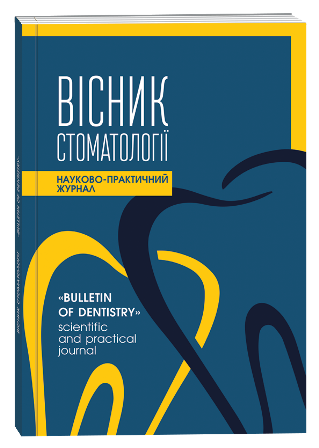EFFECTIVENESS OF USING THE PENDULUM APPLIANCE FOR DISTAL MOVEMENT OF PERMANENT MAXILLARY MOLARS IN CHILDREN
DOI:
https://doi.org/10.35220/2078-8916-2024-54-4.28Keywords:
dentofacial anomalies, Pendulum appliance, molar distalization, orthodontic treatment, childrenAbstract
Dental and jaw (dentofacial) anomalies in children represent a common problem in modern orthodontics, often leading to functional and esthetic disorders that negatively affect patients’ quality of life. One of the key objectives of orthodontic treatment is the distal movement of permanent maxillary molars to create additional space in the dental arch and normalize occlusion. The use of the Pendulum appliance is considered a promising method for distal molar movement, as it significantly reduces reliance on patient compliance. At the same time, further research into the efficacy of this technique is necessary, as well as monitoring undesirable effects associated with the movement of supporting teeth and the anterior group. The purpose of the study was to assess the effectiveness of the Pendulum appliance in the distal movement of first permanent maxillary molars in children whose second permanent molars had already erupted. Materials and methods. The study involved 11 patients aged 8 to 16 years with existing dentofacial anomalies. To achieve distal movement of the first permanent maxillary molars, the Pendulum appliance (Hilgers) was used. Lateral cephalometric radiographs were obtained before and after treatment; the analysis of angular and linear parameters was carried out using Microsoft Office Excel 2016 software. Statistical significance was determined by Student’s t-test at a significance level of p<0.01. Research results. The use of the Pendulum appliance contributed to the effective distal movement of the first permanent molars (an average of 6.8±0.61 mm) and the erupted second permanent molars (an average of 5.44±0.25 mm), thereby creating additional space in the dental arch and optimizing occlusal relationships. At the same time, certain mesial migration of the premolars and proclination of the incisors was observed, as well as moderate tooth extrusion. In most cases, these changes were temporary and partially resolved after the completion of distalization and subsequent corrective treatment. Conclusions. The use of the Pendulum appliance is an effective method for distal movement of the permanent maxillary molars in children, contributing to the creation of additional space in the dental arch and the correction of distal occlusion. Unwanted effects, such as mesial tipping of the supporting teeth and incisor proclination, are generally reversible and can be managed with appropriate clinical measures. Optimizing biomechanics and increasing the anchorage base can help minimize undesirable tooth movements and shorten treatment duration.
References
de Lira Ade L., Prado S., Araújo M.T., Sant’Anna E.F., Ruellas A.C. Distal movement of upper permanent molars using midpalatal mini-implant. Dental Press J Orthod. 2013. Vol. 18. №2. P. 18.e1-5. DOI: 10.1590/s2176-94512013000200006
Gianelly A.A. Distal movement of the maxillary molars. Am J Orthod Dentofacial Orthop. 1998. Vol. 114. №1. P. 66-72. DOI: 10.1016/s0889-5406(98)70240-9.
Alshammari A., Almotairy N., Kumar A., Grigoriadis A. Effect of malocclusion on jaw motor function and chewing in children: a systematic review. Clin Oral Investig. 2022.. Vol. 26. №3. P. 2335-351. DOI: 10.1007/ s00784-021-04356-y.
De Ridder L., Aleksieva A., Willems G., Declerck D., Cadenas de Llano-Pérula M. Prevalence of Orthodontic Malocclusions in Healthy Children and Adolescents: A Systematic Review. Int J Environ Res Public Health. 2022. Vol. 19. №12. P. 7446. DOI: 10.3390/ ijerph19127446.
Londono J., Ghasemi S., Moghaddasi N., Baninajarian H., Fahimipour A., Hashemi S., Fathi A., Dashti M. Prevalence of malocclusion in Turkish children and adolescents: A systematic review and meta-analysis. Clin Exp Dent Res. 2023 Aug. Vol. 9. №4. P. 689-700. DOI: 10.1002/cre2.771.
Caruso S., Nota A., Ehsani S., Maddalone E., Ojima K., Tecco S. Impact of molar teeth distalization with clear aligners on occlusal vertical dimension: a retrospective study. BMC Oral Health. 2019 Aug 13. Vol. 19. № 1. P. 182. DOI: 10.1186/s12903-019-0880-8.
Köle H. Surgical operations on the alveolar ridge to correct occlusal abnormalities. Oral Surg Oral Med Oral Pathol. 1959. Vol. 12. №5. P. 515-29. DOI: 10.1016/0030-4220(59)90153-7.
Frost H.M. The regional acceleratory phenomenon: a review. Henry Ford Hosp Med J. 1983. Vol. 31. №1. P. 3-9.
Фліс П.С. Ортодонтія. Вінниця: Нова книга, 2007. 312 с.
Рогач І.М., Керецман А.О., Сіткар А.Д. Правильно вибраний метод статистичного аналізу – шлях до якісної інтерпретації даних медичних досліджень. Науковий вісник Ужгородського університету. 2017. Вип. 2. С. 124-28.
Nissen S.H. The Pendulum Appliance for Class II Non-Compliance Therapy. J Clin Orthod. 2017. №51. P. 564–567.









